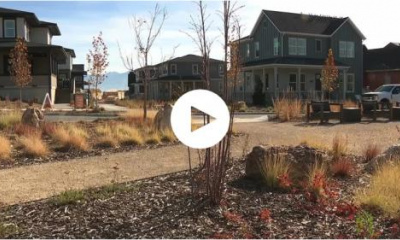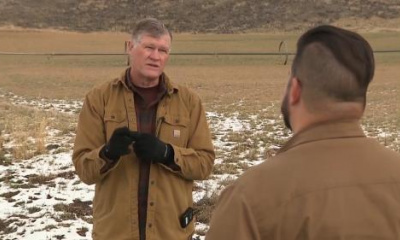At Nick Clayton’s house in Cottonwood Heights, it looks like a squadron of tiny aliens has landed. Little blue, plastic cups on tripod legs dot the lawn, placed by Charlotte and Caroline Jacketta.
The Jacketta sisters are among the Water Checkers crisscrossing neighborhoods in Salt Lake, Davis, Weber, Summit and Morgan counties as part of a program offered by Utah State University Extension. By appointment, a pair of Water Checkers visit homeowners to assess soil quality, sprinkler systems and watering schedules.
USU offers the program, for free, to help people save water by telling them how to do it efficiently.
“Water is kind of a more abstract concept in a way,” said Charlotte Jacketta. “Like, we only have so much, but people are like, ‘Well, we know we’re in a drought but it’s OK if I water too much.”
Utah State Extension estimates that about two-thirds of Utah’s drinking water is used to water lawns and that the typical homeowner uses twice as much as they really need. Charlotte Jacketta said that most of the people who call for a water check are already conscientious, but that it’s sometimes hard to know where you could be using less water.
“The grass is a big water user. And we have a lot of grass here,” Charlotte Jacketta said. “And a lot of times people don’t know how much to water, how long to water, when to water, how many days per week. So we run tests on the turf areas that tell us how much water is being put out, and how evenly the water is being spread.”
The blue cups test the sprinkler system’s water distribution. At the end of the water check, the homeowner receives an email with color-coded maps showing the measurement of their lawn and how well the water is being dispersed. The report also recommends an optimized watering schedule and an analysis of each sprinkler head — when it’s clogged, broken or tilted.
As concerns heighten about the shrinking Great Salt Lake, experts are looking at both household and agricultural irrigation more closely.
“For this program, I would say that every drop (pun intended) of water efficiency gained by reducing outdoor water use helps to keep waters in the tributaries of the Great Salt Lake,” Kelly Kopp, told the Great Salt Lake Collaborative in an email. The director of the Water Checker program, and professor in USU’s department of plants, soil and climate, added that saving water defers future dams and distribution systems off those tributaries to support the state’s rocketing growth. “And since outdoor water use comprises the majority of per capita water use in the urban/suburban sector, there is great potential and opportunity there.”
Kopp said the program has proven to reduce water usage, which they track with data from water utilities, when they’re able to access that data.
Following their water audit, Salt Lake City resident participants reduced their consumption of water for irrigation by 7,900 gallons per month and kept that progress up.
A limitation of the Water Check program is its reach: 175 commercial industrial and institutional participants and 3,000 residential properties in Sandy and Salt Lake City since 2005. She expects to add 500 more residential participants this summer because demand is high.
Even if every property owner does their part, USU water efficiency experts have noted that the water savings from landscaping wouldn’t be enough to meet the needs of Great Salt Lake, since it represents a small portion of the amount of water diverted from the lake’s tributaries. Agriculture water conservation audits are also being conducted, too.
“As an opt-in program, we can and do reach those who are already water-conscious,” Kopp said. “But we also reach many who are new to the area or have little to no landscape management experience.”
“It is true that this program won’t save the GSL, but it does contribute,” she added.
At Clayton’s house, the Water Checkers pick up the little blue cups one by one, and report the amount of water in them on an iPad. They bring the iPad to Clayton, who is controlling the sprinkler system through an app on his phone.
Clayton’s backyard is lush with fruit trees, grape vines, and flowering plants.
“I want to use as little water as I can, and still have tomatoes and zucchini and migratory stuff for butterflies,” he said. “And I love my walnut tree.”
He had some damaged sprinkler heads, and about 50 percent of his yard was getting watered equally, which Charlotte said is pretty average. But with a couple of repairs, Clayton’s watering is just fine.
Such changes are small scale, but Charlotte Jacketta said it is meaningful work for a summertime job. “I get to see a lot of cool yards, meet a lot of different people and get to help save water, which is something I’m very passionate about.”
How to save water at your house:
Sign up for a free water check here.
Learn how often you should be watering your lawn each week this summer based on conditions in your county here.
Outdoor watering tips for your lawn from SlowtheFlow.org:
- Water less and save about 3,000 gallons of water per average quarter-acre yard.
- Don’t water if it’s windy, above 5 mph, because water will blow where it’s not needed and evaporate.
- Water at night, from 6 p.m. to 10 a.m., or after 8 p.m. in Southern Utah, to reduce evaporation loss.
- Water grass last and prioritize trees and shrubs.
- Set mower blades to 3”-4” because taller grass has deeper roots.
- Buy smart irrigation controllers with rebates.
Find more for indoor use, too, at SlowtheFlow.org








